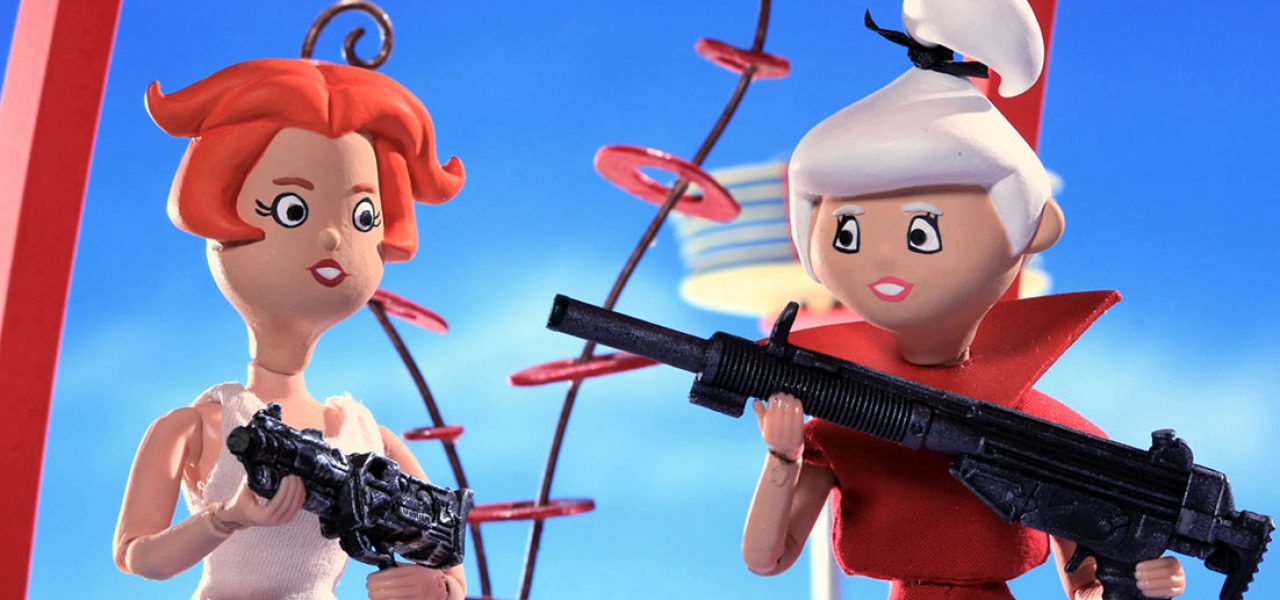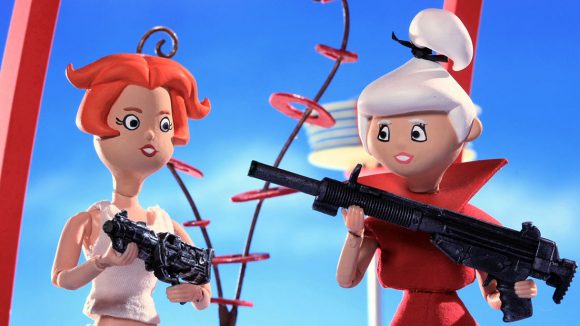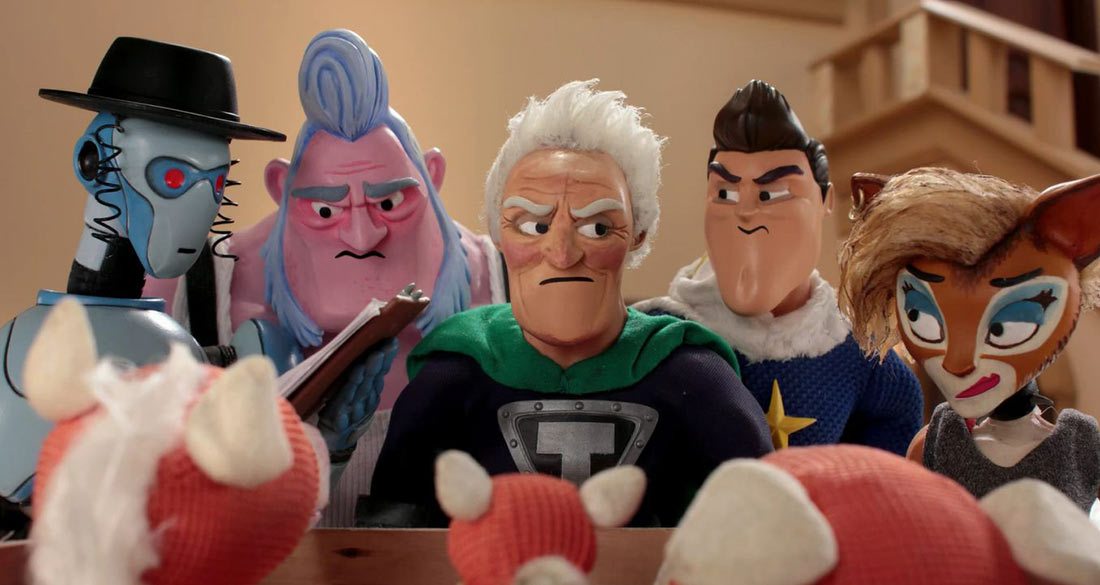

Exclusive: Artists At Stoopid Buddy, Studio Behind ‘Robot Chicken,’ Are Uniting To Unionize
An effort to organize the artists at Burbank, California-based Stoopid Buddy Stoodios with the International Alliance of Theatrical Stage Employees (IATSE) union has gained momentum in recent weeks, according to a source inside the studio.
Stoopid Buddy, the largest stop motion studio in southern California with about 200 employees, is the creative force behind the Adult Swim smash hit Robot Chicken, as well as Sony/Crackle’s Supermansion, the upcoming Netflix kids’ series Buddy Thunderstruck, and Denny’s popular advertising web shorts Grand Slams. The studio is owned by actor Seth Green, and three other partners: Eric Towner, Matt Senreich, and John ‘Harv’ Harvatine IV.
Cartoon Brew is told by its source, a union organizer within the studio, that the low wages for lower-level staff causes significant turnover, with fed-up staffers often leaving the studio. The studio frequently replaces departing staff with younger, inexperienced artists fresh out of art school, who subsequently require hours of training to get up to speed. The inexperienced hires, who are often just happy to have a job at the studio, frequently have little idea of their true value to the studio and have little negotiating experience. As a result, wages are lowered, and the work schedule suffers, with many additional hours required by all of the staff to catch up.
One of the key goals of the current unionizing effort is for greater wage-scale transparency, so that staffers can have an idea of their colleagues’ pay rates — and know whether they are being treated fairly or not. Another goal is better health insurance. For years, the studio failed to provide health insurance at all for its employees, which was one of the leading causes for an attempt at unionization in the spring of 2015. The attempt failed, though the studio asked employees for a list of “demands” that might placate the staff and tamp down unionizing efforts for good.

Among those demands was health insurance. The studio waffled, delayed, and postponed, until finally, on the final day before a state law requiring health insurance went into effect, the studio signed up with what has been described as a “bottom-barrel” health plan for its employees.
To choose union representation, eligible artists must complete a union card anonymously on the IATSE website. Sixty-five per cent of those artists must sign a card for the union to become involved, and according to Cartoon Brew’s source, union organizers at Stoopid Buddy feel confident that they can reach this minimum threshold.
Momentum for the unionizing effort has been spurred by the studio’s starting wages for artists, including assistant animators, compositors, and other visual effects staff that hover just above California’s $10 minimum wage.
Animators’ starting wages begin at about $20 per hour, and, after a year of satisfactory work, they can expect a raise of $1 or $2 per hour. Wages in the stop motion animation industry have shrunk in recent years, with rates lower than what they were ten years ago, without even taking inflation into account. This has happened despite a relative boom in the industry, with L.A.-based productions such as Amazon’s Tumbleleaf and the Oscar-nominated feature Anomalisa, as well as high-profile features incorporating stop motion such as Kubo and the Two Strings and The Little Prince, as well as prominent utilization of the technique in the advertising sphere.
Cartoon Brew’s source emphasized that union organizers enjoy Stoopid Buddy Stoodio; they are inspired by their work creatively, and want the studio to succeed. The unionizing effort is not meant to hurt or punish the studio, but instead aims to improve the work environment by boosting employee morale, health, and happiness. They are sensitive to the studio’s own financial pressures, and expressed a willingness to accept a collective bargaining effort that recognizes those realities.
Studio management, however, has not taken kindly to organizing efforts. They recently circulated to staff an eight-page letter purporting to answer union arguments about the benefits of unionizing. The letter, which begins by referring to “our Stoopid Family” and proceeds to present arguments against unionization, may have done more to harm to the studio’s position than to help, and many employees saw it as a clumsy effort by studio management to forestall the unionizing effort.

The letter seemed “written by a lawyer,” according to our source, and only served to highlight how ultimately the studio was a business rather than a family, with references to a “reasonable return on investment to [the studio’s] owners” and risks of a production shutdown.
The letter makes the point that were the studio to be unionized, Stoopid Buddy would be the only stop motion studio to be a union shop. As a result, due to potentially increased wages that their competitors would not need to meet, the studio may not be able to compete effectively for commercial jobs.
But the letter also argues that wages may increase, decrease, or stay the same, and warns that lower-performing employees may benefit while high performers may suffer, because the studio’s ability to reward performance could be handcuffed by higher minimum wages.

Stoopid Buddy also attempted to discourage would-be union artists by warning that there was no guarantee a union negotiation would result in a pension plan or improved health insurance. The union organizer at the studio acknowledged that, while those points may be true, a unionized staff could band together to collectively bargain, which is more advantageous than negotiating with the studio one by one.
For now, the unionizing efforts continue to take place at the studio. If the employees are able to reach the IATSE’s 65% threshold, the IATSE would then request that Stoopid Buddy voluntarily recognize IATSE as the workers’ representatives or compel the National Labor Relations Board to conduct a secret ballot election to determine whether a majority of workers want union representatives to negotiate an employment agreement with the studio. In the case of such an election, only a 50%+1 majority is needed to gain union representation. Should the union effort prevail, the employee union organizers would become the bargaining committee and work with IATSE representatives to formally begin negotiations with studio management.
Representatives for IATSE and the Animation Guild declined to comment due to the ongoing effort to unionize.
Stoopid Buddy Stoodios did not respond to to repeated requests for comment.
